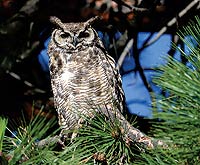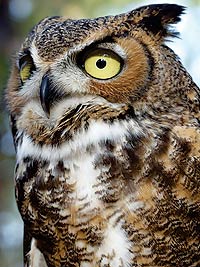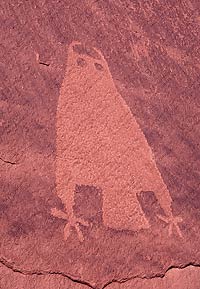 There is something magical about hearing the deep baritone whoos of a great horned owl calling in the night. The classic cadence of their calls resembles the phrase, “Who’s awake? Me, too.” Perhaps a rhetorical question since you’d have to be up to hear them.
There is something magical about hearing the deep baritone whoos of a great horned owl calling in the night. The classic cadence of their calls resembles the phrase, “Who’s awake? Me, too.” Perhaps a rhetorical question since you’d have to be up to hear them.
Great horned owls are the most common and widely distributed owl in North America. They occupy just about every habitat from rural to urban and from open deserts to mountain forests, though they tend to be absent from areas above timberline. These raptors take a wide variety of prey including rodents, small mammals, birds, reptiles, amphibians, large insects, and even the occasional cat slinking about at night. Skunks, which most predators avoid for good reason, also fall prey to these birds because they lack a sense of smell and aren’t repulsed at the skunk’s aroma. Jackrabbits, cottontails, mice, and other small mammals probably constitute the main diet.
And if you’re wondering about the strength of their grip, great horneds can exert over 500 psi (pounds per square inch) of pressure when grasping prey; a stark contrast to the 85-150 psi exserted by me squeezing my hand as tightly as I can.

Their scientific name, Bubo virginianus, is derived from the Latin word for owl, bubo, and virginianus, refers to Virginia where the type specimen was first collected.
Though massive looking, great horneds are mostly feathers and hollow bones. Average weight for these birds is around 2-3 pounds and in the wild, lifespans average 8-10 years. The oldest known banded owl was 28 years-old when it was found with an injury that prevented its release back into the wild and the bird was sent to a wildlife care facility.
In December, these owls can be heard calling throughout the Canyon Country as males defend territories and communicate with their mates. Females, which also hoot in response, have a higher pitch than males – a nice contrast when the birds are duetting. Females also make a harsh, raspy high-pitched screech that may be confused with the drawn-out raspy call of a barn owl. Juvenile great horneds also make a high-pitched screech that is less raspy than the adult’s call.
The birds nest early in the season, generally by January or February, and utilize abandoned (or usurped) hawk, heron, crow, or raven nests, but will also use alcoves or cliff ledges for their nesting sites. These owls don’t build their own nests but may add some feathers to the nest bowl. The early jump on the nesting season provides the juveniles with a longer development period to become proficient hunters before they leave their natal area.
Great horned owls, named for their large ear tufts, vary in plumage from tawny to a grayish/brown with dark barring on the feathers, and a white throat patch. This cryptic coloration allows them to stay concealed throughout the day, although scolding jays or mobbing songbirds may try to drive a roosting bird away. In winter, the birds may be spotted roosting in willows or cottonwoods, their bulky shape betrayed by the leafless tree. Like many birds of prey, great horneds will have favorite perching spots indicated by the number of pellets – regurgitated masses of fur and bones – that litter the ground beneath their roost. Careful examination of these pellets reveals the owl’s prey.
So, when most folks are heading inside during the colder winter months, bundle up and step outside to listen for the baritone calls of the great horned owl set against the stillness of a winter’s night. Spectacular!